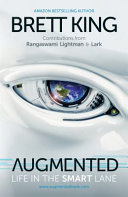

The book explores the historical context and evolution of augmented reality (AR) technologies, tracing their origins from early concepts to modern applications. It highlights key milestones in the development of AR, including technological advancements and the convergence of various fields such as computer vision, artificial intelligence, and mobile computing. The narrative emphasizes how AR has transitioned from niche applications to mainstream usage, impacting industries like gaming, healthcare, education, and retail. The author discusses pivotal moments, such as the introduction of smartphones with advanced sensors and cameras, which democratized access to AR experiences. This evolution is framed within the broader context of human-computer interaction, illustrating how AR has changed the way we perceive and interact with the digital world. The discussion also includes the challenges faced during this evolution, such as technical limitations, user acceptance, and ethical considerations surrounding privacy and data security.
Continue readingThe book delves into the societal implications of augmented reality, examining how AR technologies are reshaping communication, entertainment, and education. It discusses the potential for AR to enhance social interactions and create immersive experiences that foster deeper connections among users. The author presents case studies showcasing how AR is being utilized in classrooms to enhance learning experiences, enabling students to visualize complex concepts and engage with content in interactive ways. Additionally, the book addresses the ethical considerations of AR's influence on society, such as the potential for misinformation and the digital divide. It raises critical questions about the responsibilities of developers and companies in creating AR content that is not only engaging but also socially responsible and inclusive. The narrative encourages readers to reflect on the balance between innovation and ethical considerations in the deployment of AR technologies.
Continue readingThe book highlights the transformative potential of augmented reality in various business sectors, including manufacturing, retail, and healthcare. It outlines how companies are leveraging AR to streamline operations, enhance customer experiences, and improve training processes. For instance, AR can provide real-time data visualization for factory workers, enabling them to perform tasks more efficiently and accurately. In retail, AR applications allow customers to visualize products in their own environments before making a purchase, thereby reducing return rates and increasing customer satisfaction. The author provides insights into successful AR implementations in different industries, showcasing the measurable benefits and return on investment. Furthermore, the discussion includes the challenges businesses face in adopting AR, such as the need for significant investment in technology and training, as well as the importance of integrating AR solutions with existing systems and workflows.
Continue readingThe book emphasizes the importance of user experience (UX) and design principles in the development of augmented reality applications. It discusses how AR experiences must be intuitive and user-friendly to ensure widespread adoption. The author outlines key design considerations, such as the need for seamless integration of digital content with the real world, minimizing user distraction, and providing clear navigation cues. The narrative includes examples of successful AR applications that prioritize user experience, illustrating how thoughtful design can enhance engagement and satisfaction. Additionally, the book addresses the unique challenges of designing for AR, including spatial awareness, context sensitivity, and the varying levels of user familiarity with technology. It encourages designers and developers to adopt a user-centered approach, involving real users in the design process to gather feedback and iterate on solutions.
Continue readingThe book speculates on future trends and advancements in augmented reality technology, considering the potential for further integration with artificial intelligence, machine learning, and the Internet of Things (IoT). It discusses emerging technologies that could enhance AR experiences, such as improved hardware capabilities, advanced sensors, and more sophisticated algorithms for object recognition and tracking. The author envisions a future where AR becomes an integral part of everyday life, facilitating seamless interactions between the digital and physical worlds. The narrative also touches upon the potential for AR to influence areas such as remote work, telepresence, and virtual collaboration, particularly in the wake of the COVID-19 pandemic. The discussion encourages readers to think critically about the implications of these advancements, including potential societal changes and the need for ethical frameworks to guide the development of AR technologies.
Continue readingThe book addresses the ethical dimensions of augmented reality development, emphasizing the need for responsible practices in the creation and deployment of AR technologies. It discusses potential ethical dilemmas, including issues related to privacy, data security, and user consent. The author argues that as AR becomes more pervasive, developers and companies must prioritize ethical considerations to build trust with users and mitigate potential harms. The narrative includes discussions on the importance of transparency in AR applications, ensuring users are aware of how their data is being used and providing options for control over personal information. Additionally, the book highlights the role of regulatory frameworks in guiding ethical AR development, advocating for collaboration between industry stakeholders, policymakers, and ethicists to establish guidelines that promote responsible innovation.
Continue readingThe book underscores the significance of community and collaboration in the advancement of augmented reality technologies. It highlights how open-source initiatives, developer communities, and collaborative projects contribute to the rapid evolution of AR. The author shares examples of successful AR projects that emerged from community-driven efforts, illustrating the power of collective creativity and knowledge sharing. The narrative emphasizes the importance of fostering an inclusive environment that encourages diverse perspectives and contributions from various stakeholders, including developers, designers, researchers, and end-users. The book advocates for building partnerships across industries and disciplines to drive innovation in AR, suggesting that collaboration can lead to more robust and impactful solutions that address real-world challenges.
Continue reading